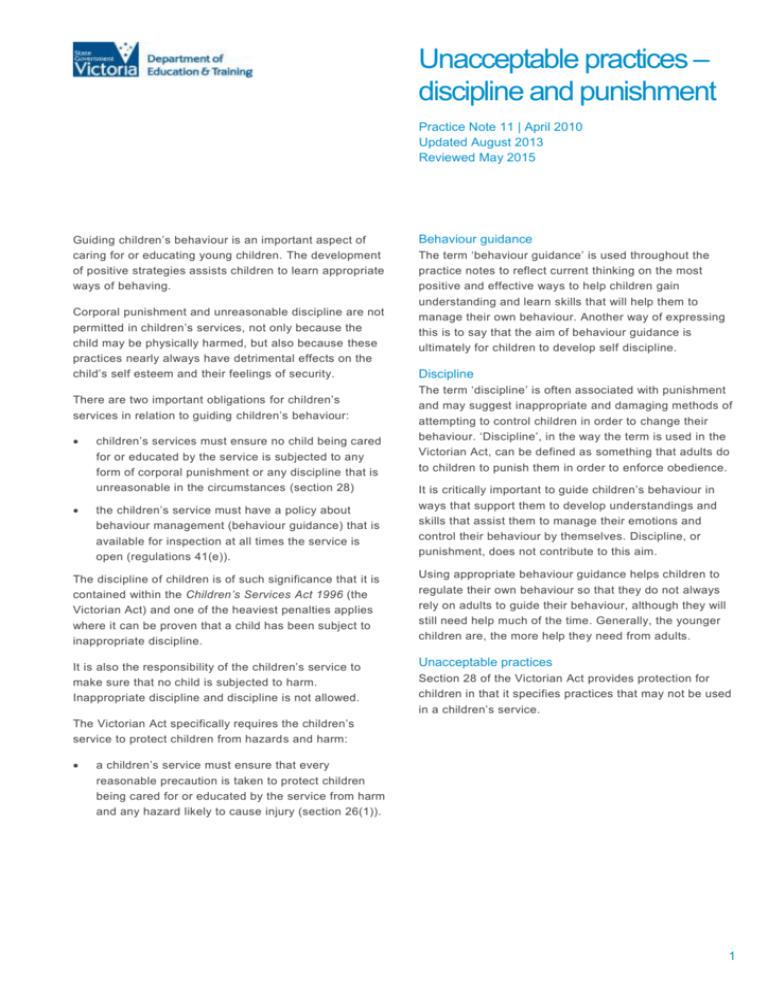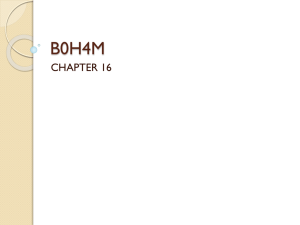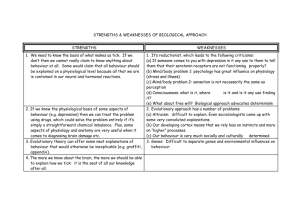Unacceptable practices - discipline and punishment (docx
advertisement

Unacceptable practices – discipline and punishment Practice Note 11 | April 2010 Updated August 2013 Reviewed May 2015 Guiding children’s behaviour is an important aspect of caring for or educating young children. The development of positive strategies assists children to learn appropriate ways of behaving. Corporal punishment and unreasonable discipline are not permitted in children’s services, not only because the child may be physically harmed, but also because these practices nearly always have detrimental effects on the child’s self esteem and their feelings of security. There are two important obligations for children’s services in relation to guiding children’s behaviour: children’s services must ensure no child being cared for or educated by the service is subjected to any form of corporal punishment or any discipline that is unreasonable in the circumstances (section 28) the children’s service must have a policy about behaviour management (behaviour guidance) that is available for inspection at all times the service is open (regulations 41(e)). Behaviour guidance The term ‘behaviour guidance’ is used throughout the practice notes to reflect current thinking on the most positive and effective ways to help children gain understanding and learn skills that will help them to manage their own behaviour. Another way of expressing this is to say that the aim of behaviour guidance is ultimately for children to develop self discipline. Discipline The term ‘discipline’ is often associated with punishment and may suggest inappropriate and damaging methods of attempting to control children in order to change their behaviour. ‘Discipline’, in the way the term is used in the Victorian Act, can be defined as something that adults do to children to punish them in order to enforce obedience. It is critically important to guide children’s behaviour in ways that support them to develop understandings and skills that assist them to manage their emotions and control their behaviour by themselves. Discipline, or punishment, does not contribute to this aim. The discipline of children is of such significance that it is contained within the Children’s Services Act 1996 (the Victorian Act) and one of the heaviest penalties applies where it can be proven that a child has been subject to inappropriate discipline. Using appropriate behaviour guidance helps children to regulate their own behaviour so that they do not always rely on adults to guide their behaviour, although they will still need help much of the time. Generally, the younger children are, the more help they need from adults. It is also the responsibility of the children’s service to make sure that no child is subjected to harm. Inappropriate discipline and discipline is not allowed. Unacceptable practices Section 28 of the Victorian Act provides protection for children in that it specifies practices that may not be used in a children’s service. The Victorian Act specifically requires the children’s service to protect children from hazards and harm: a children’s service must ensure that every reasonable precaution is taken to protect children being cared for or educated by the service from harm and any hazard likely to cause injury (section 26(1)). 1 The following examples of corporal punishment and unreasonable discipline are considered serious breaches of the Act: A staff member or family day carer should always remain with the child. Time out hitting or slapping force feeding yelling at or belittling humiliating a child physically dragging a child depriving a child of food or drink. e.g. saying to a child ‘if you don’t eat your vegetables you can’t have dessert”. Other examples of unacceptable practice are: negative labelling criticising discouraging blaming or shaming making fun of or laughing at using sarcastic or cruel humour excessive use of negative language, such as, “no” “stop that!” “don't…” “you never...” . ‘Time out’ means different things to different people. In the context of the Act and Regulations, time out is defined as removing a child for a period of time to an alternative place and in isolation. Isolating the child not only has the potential to cause fear and/or humiliation, but it also is likely to increase negative behaviour at other times. It does not help children develop positive behaviour or feelings of self worth. All services are required to operate in a way which ensures that children are safe, that their developmental needs are being met and that they are adequately supervised at all times. Use of time out in this context is inappropriate and could be considered as unreasonable discipline. If it is necessary to take the child to an alternative environment an adult must remain with the child at all times. This allows the adult to support the child to calm down. Restraint Cool down and time out In some situations it may be necessary to take a child to an alternative environment to support the child to calm down or regain self control. The staff member or family day carer must remain with the child, offering reassurance and support. Cool down A cooling down period is a time when children can settle down and regain self control. This strategy can be used as an opportunity for the adult to help the child develop self-calming behaviours and gain composure and control. The difference between ‘cool-down time’ and ‘time out’ is that the adult stays with the child and supports the child to regain control of their emotions. It is viewed as a learning opportunity, not as punishment. Occasionally, there may be circumstances where a child becomes overstimulated and out of control and may need to be removed from the situation. However, this approach should only be used as part of a behaviour plan and when there is an immediate danger of the child being hurt or hurting others and when other strategies to guide the child’s behaviour have not worked. The definition of restraint is ‘limiting or preventing freedom of movement’. Children should be physically restrained only in emergency situations. Examples of emergency situations include when the child is: in a clearly unsafe situation, for example attempting to scale a fence or climb a tree physically threatening other children or adults behaving in ways that are destructive to themselves, other people or the environment. These situations may require supportive holding of children. This means that children are only held long enough to be removed from the situation. Informing parents when different behaviour management strategies are used If you have taken the child away from the other children in order to help them calm down or physically restrained the child in any way, you should inform the child’s parent or guardian of the circumstances and what happened at the time. 2 Behaviour guidance policy It may be helpful to include in a behaviour guidance policy the steps that will be taken if an adult has used inappropriate discipline with a child. Including this as part of the behaviour guidance policy reassures parents that there is open and transparent communication between the children’s service and families, as well as providing staff members and family day carers with clear guidelines to follow. Where there is a police investigation the Department liaises with the police and will conduct an investigation into breaches of the Victorian Act and the Children’s Services Regulations 2009 where appropriate. Related Practice Notes Behaviour guidance Understanding children’s behaviour Challenging behaviours Notification of inappropriate use of discipline Strategies to guide children’s behaviour When a complaint alleges that the health, safety or wellbeing of any child within the children’s service may have been compromised, the proprietor must deal with and respond to the complaint discreetly and as soon as is practicable in the circumstances. Developing a behaviour guidance policy The proprietor must notify the Department of Education and Training (Department) by telephone within 48 hours, followed by written notification as soon as practicable (regulation 105). Regulation 90 also requires the proprietor to notify the Department by telephone within 24 hours, followed by written notification as soon as is practicable, of any incident involving injury or trauma to a child while being cared for or educated by a children’s service and requiring the attention of a registered medical practitioner. Parents must also be notified as soon as practicable of any incident or accident (regulation 91). Any notification that the Department receives alleging corporal punishment of children or unreasonable discipline in the circumstances will be considered by the Department. When the Department is notified of an incident or complaint relating to an allegation of sexual or physical assault of a child whist in the care of a children’s service, the matter will be referred to Victoria Police for criminal investigation. During an investigation by Victoria Police, authorised officers will ensure that the proprietor operates the service in a way that: ensures the safety of the children being cared for or educated by the service ensures that the developmental needs of those children are met supports the health and wellbeing of those children. 3




